One of the most important pieces of reducing snow plow damage is to have the proper equipment for the job whether the primary focus is driveways, roads, or parking lots. I big part of choosing the right equipment is finding equipment with features designed to reduce impact on plowing surfaces and/or increase visibility for a safer snow removal experience.
In this article, we’ll break down the product features designed to reduce snow plow damage as well as which products offer these features and additional tips for plowing safely.
Snow Plow Damage Reducing Plow Features
- Plastic Skids
- Floating Skids
- Trip Edge
- Poly Cutting Edge
- Sectional Cutting Edge
- Hydraulic Relief
- Oscillation
- Vertical Float
- Piston Accumulator Relief
- Laser Guides
1. Plastic Skids
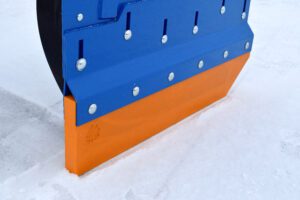 Plastic or poly skids are designed to absorb impact and even flex a bit when coming in contact with objects, such as curbs.
Plastic or poly skids are designed to absorb impact and even flex a bit when coming in contact with objects, such as curbs.
As a softer material than steel, they also are gentler on any surface they slide across, including lawns. This note only reduces the risk of chipping, breaking and/or gouging curbs, substrates or grassy areas, but it also reduces the transfer of energy back to the machine and operator.
2. Floating Skids
 A floating skid is one that is allowed to travel vertically, independent of the rest of the plow or containment box when coming in contact with surfaces that sit higher than the substrate – such as a curb – and then return to its original position. This is generally achieved through the use of springs.
A floating skid is one that is allowed to travel vertically, independent of the rest of the plow or containment box when coming in contact with surfaces that sit higher than the substrate – such as a curb – and then return to its original position. This is generally achieved through the use of springs.
Think of it much like a breakaway rim in basketball. It absorbs the impact by softening the blow and when the pressure is released, it returns to normal. A breakaway rim reduces the risk of damaging the backboard, while the floating skid reduces risk of damaging both the plow its attached to and the surface it comes in contact with.
3. Trip Edge
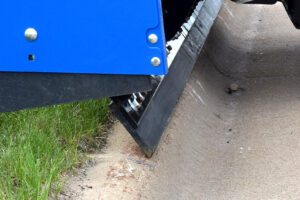 A trip edge also employs the same concept as a breakaway rim – only it happens at the cutting edge area. When plowing up to a curb, over speed bumps or humps, or even areas where there are lips of thick ice that would stop a snow plow in its tracks, a trip edge will allow the cutting edge to fold back – or break away – enabling the plow to continue traveling forward.
A trip edge also employs the same concept as a breakaway rim – only it happens at the cutting edge area. When plowing up to a curb, over speed bumps or humps, or even areas where there are lips of thick ice that would stop a snow plow in its tracks, a trip edge will allow the cutting edge to fold back – or break away – enabling the plow to continue traveling forward.
It also keeps downward pressure on the cutting edge to continue pushing snow forward and return to its original cutting angle one excessive force is no longer present. This helps prevent damage to immovable objects, the plows and the machines.
4. Poly Cutting Edge
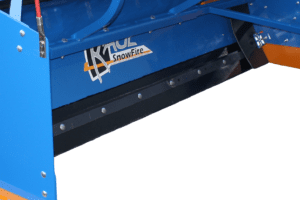 While steel or carbide cutting edges are known for their ability to scrape thoroughly down to the substrate, even with hard snow pack, poly cutting edges, sometimes called poly blades, are gentle on delicate surfaces.
While steel or carbide cutting edges are known for their ability to scrape thoroughly down to the substrate, even with hard snow pack, poly cutting edges, sometimes called poly blades, are gentle on delicate surfaces.
The polyurethane material is a form of plastic that is softer than steel and harder than rubber, allowing you to get a good scrape without being as harsh on the substrate as steel or wearing out as fast as rubber.
Poly cutting edges are often preferred for gravel roads and cobblestone streets.
5. Sectional Cutting Edges
 Sectional cutting edges are designed to allow you to continue using steel or carbide cutting edges for maximum scraping of hard-packed snow or ice while minimizing snow plow damage.
Sectional cutting edges are designed to allow you to continue using steel or carbide cutting edges for maximum scraping of hard-packed snow or ice while minimizing snow plow damage.
The spring-loaded sections contour with the plowing surface by offering controllable constant pressure when plowing over bumps, depressions, crowns and wheel paths.
It even allows the plow to safely travel over manhole covers while making a clean scrape.
6. Hydraulic Relief Valve
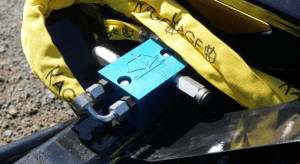 The purpose of hydraulic relief valves is really to protect the hydraulic system of a skid steer, tractor or loader machine against damage.
The purpose of hydraulic relief valves is really to protect the hydraulic system of a skid steer, tractor or loader machine against damage.
It directs the transfer of hydraulic fluid to another hydraulic line within the plow in the event of excessive pressure, instead of sending the fluid back to the machine. This generally happens when a plow comes in contact with an immovable object.
7. Oscillation
 The purpose of snow plow oscillation is to maintain constant contact with the plowing surface on side slants or when angle plowing without digging the corners of the plow into the substrate.
The purpose of snow plow oscillation is to maintain constant contact with the plowing surface on side slants or when angle plowing without digging the corners of the plow into the substrate.
This is achieved by allowing the plow blade or moldboard to pivot in the center and essentially “teeter totter” in a controlled manner to keep the pressure on both ends of the plow consistent vertically.
8. Vertical Float
 Vertical float works in a similar manner to oscillation, except it allows vertical movement universally across the plow to control down pressure and follow the ground’s contours – especially when travelling up or down hills.
Vertical float works in a similar manner to oscillation, except it allows vertical movement universally across the plow to control down pressure and follow the ground’s contours – especially when travelling up or down hills.
This helps prevent the plow from “digging in” excessively to the plowing surface.
When a “floating plow” is used on a wheel loader, it also allows the front tires of the loader to maintain better traction with the pavement, blacktop, etc. for better control and steering.
9. Piston Accumulator Relief
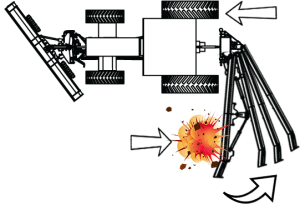 Piston accumulator relief allows a snow blade to fold back – or break away – if it hits an immovable object, and then return back to its original position.
Piston accumulator relief allows a snow blade to fold back – or break away – if it hits an immovable object, and then return back to its original position.
This reduces the impact on both the object and the machine in the case of incidental contact, and allows the operator to continue plowing without major incident.
10. Laser Guides
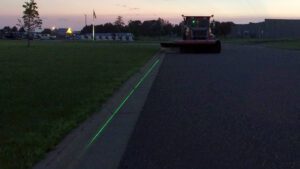 Laser guides are safety accessories for plowing snow that allows you to see the future path of rear blades, such as wing plows, when traveling forward. Laser plow guides project a lighted line on the road, driveway, parking lot, etc. in front of the truck, tractor or loader so the plow operator can more accurately predict the path of the rear plow without having to look back at the wing plow as often.
Laser guides are safety accessories for plowing snow that allows you to see the future path of rear blades, such as wing plows, when traveling forward. Laser plow guides project a lighted line on the road, driveway, parking lot, etc. in front of the truck, tractor or loader so the plow operator can more accurately predict the path of the rear plow without having to look back at the wing plow as often.
Equipment Designed To Prevent Snow Plow Damage
The SnowFire BLAST
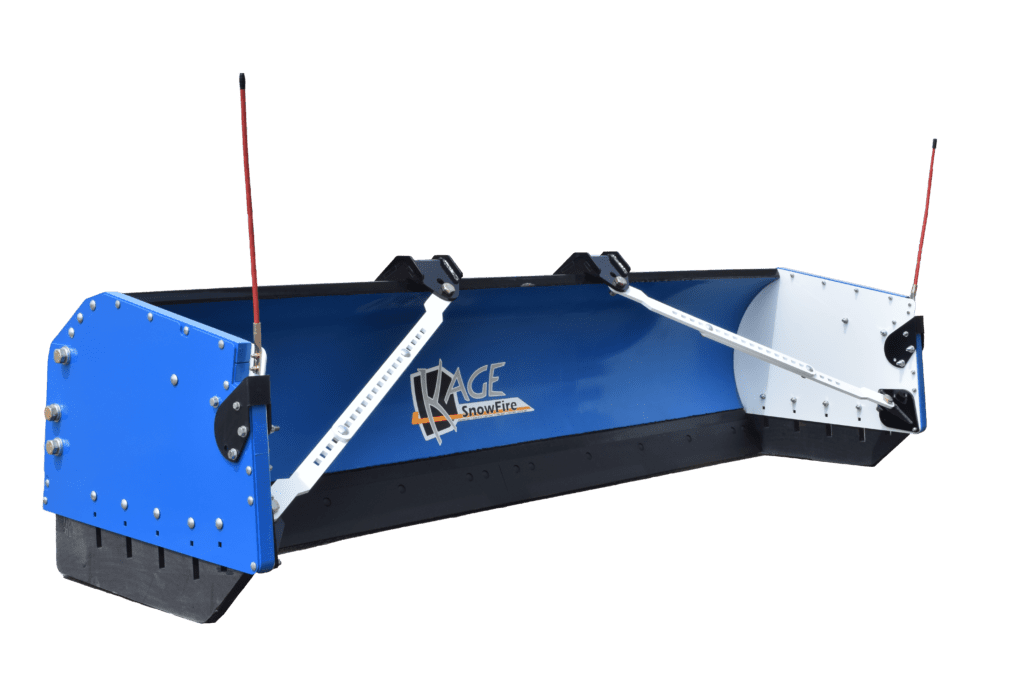 The SnowFire BLAST is a floating snow pusher designed for machines such as skids steers, tractors, compact wheel loaders, and telehandlers. This plow works best on machines weighing 5k – 15k lbs.
The SnowFire BLAST is a floating snow pusher designed for machines such as skids steers, tractors, compact wheel loaders, and telehandlers. This plow works best on machines weighing 5k – 15k lbs.
This snow plow pusher is equipped with the following snow plow damage reducing features:
- Floating Skids
- Trip Edge
- Optional Poly Cutting Edge
- Oscillation
- Vertical Flat
- Optional Advantedge
It’s ability to float in various ways allows the plow to ride over obstacles with little to no impact on the driver or substrate – making it the ultimate snow pusher.
The Snowfire, SnowStorm, and SnowDOZER
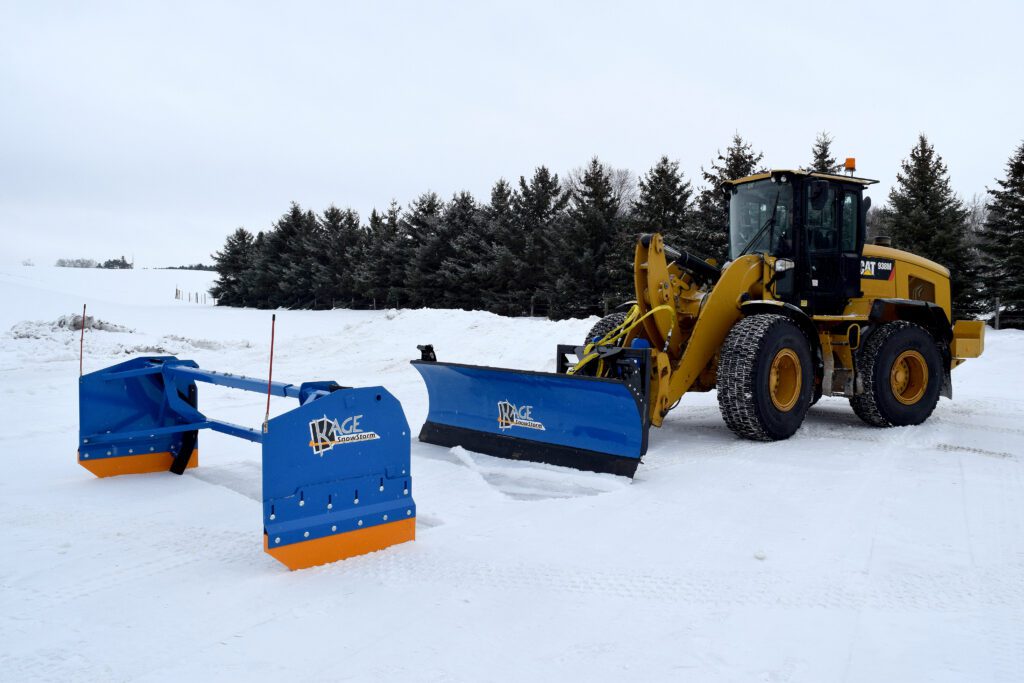 Each of the 2-in-1 blade and box systems reduce snow plow damage and decrease plowing time up to 4 times! The SnowFire, SnowStorm, and SnowDOZER each have detachable boxes and other unique features that gives them maximum maneuverability and reduced snow plow damage. These are designed for machines from 5k up to 50k lbs.
Each of the 2-in-1 blade and box systems reduce snow plow damage and decrease plowing time up to 4 times! The SnowFire, SnowStorm, and SnowDOZER each have detachable boxes and other unique features that gives them maximum maneuverability and reduced snow plow damage. These are designed for machines from 5k up to 50k lbs.
The angle plow and pusher systems are equipped with the following snow plow damage reduction features:
- Hydraulic Relief Valve
- Trip Edge
- Poly Skids
- Oscillation
- Optional Poly Cutting Edge (SnowFire only)
- Optional Sectional Cutting Edge
These features protect operators, their equipment and snow plowing obstacles from injury or damage.
The ShadowBlade
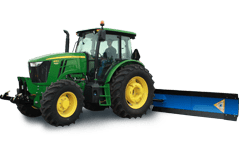 KAGE’s ShadowBlade is a unique wing plow that attaches to the back of a tractor.
KAGE’s ShadowBlade is a unique wing plow that attaches to the back of a tractor.
This tractor pull plow is equipped with the following safety features:
- Piston Accumulator Relief
- Optional Sectional cutting edge
It also works well in conjunction with:
- wing plow lasers
The Wingline
 The Wingline is a unique laser guide that is mounted inside the cab, generally in state, county or city municipal trucks. This is designed for the operator to project a lighted green laser line in front of the machine to gauge where the plow is currently and where it will end up. This allows the operator to forsee potential issues and avoid them before it’s too late.
The Wingline is a unique laser guide that is mounted inside the cab, generally in state, county or city municipal trucks. This is designed for the operator to project a lighted green laser line in front of the machine to gauge where the plow is currently and where it will end up. This allows the operator to forsee potential issues and avoid them before it’s too late.
This is an excellent complement to the ShadowBlade 3-point plow.
The AdvantEdge
 The AdvantEdge live cutting edge that can be mounted to any snow plow with a standard highway DOT punch such as the SnowFire BLAST, SnowFire, SnowStorm, SnowDOZER, ShadowBlade, municipal truck plows, pickup truck plows and snow pushers.
The AdvantEdge live cutting edge that can be mounted to any snow plow with a standard highway DOT punch such as the SnowFire BLAST, SnowFire, SnowStorm, SnowDOZER, ShadowBlade, municipal truck plows, pickup truck plows and snow pushers.
A live cutting edge helps scrape the substrate better, by allowing it to flex over crowns and dips in the ground. It also reduces driver fatigue by making it easier to ride over unforeseen objects such as manholes.
Damage Reducing Snow Plowing Practices
Proper Training
On of the key components to reduce snow plow damage in the field is to ensure that the snow plow operator is properly trained in using the equipment. Understanding the plow’s capabilities, limitations, and safe operation practices can prevent accidents and damage.
Regular Maintenance
Keeping the snow plow and equipment well maintained according to the manufacturer’s instructions helps ensure that the equipment is functioning properly. By following the instructions, it will keep the equipment in prime condition and reduce failed components.
Regular inspections and servicing can identify potential issues early and prevent them from escalating into more significant problems. This keeps the operator, machine, plow, and site in ideal condition.
Avoid Obstacles
Train operators to be vigilant and avoid hitting curbs, raised manholes, parking blocks, and other obstacles. Collisions with these objects can cause significant damage to the obstacle, plow and other machine components.
Use Shoes/ Wear Bars
Some plows come with replaceable shoes or wear bars at the bottom of the plow blade. These components can help protect the blade from wear and tear and prevent damage to the pavement. Take advantage of the manufacturers options to extend the life of your equipment such as a carbide edge extender, curb guard, and poly skids.
Pre-treatment and De-icing
If pre-treatment or de-icing is an option, it is best to use it. Pre-treating the road with salt or de-icing materials before plowing can help reduce the snow’s adherence to the pavement because it creates a layer between the snow and pavement much like a non-stick frying pan, making plowing easier and less abrasive on the plow. It also eats away at large ice patches to avoid an abrupt stop if the operator hits it.
One such way to apply an anti-ice pretreatment is to use a skid steer and 3-point sprayer attachment such as KAGE LiquidRage brine sprayer and its optional brine mixer.
Be Mindful of Hidden Obstacles
Snow can cover hidden objects, such as curbs, boulders, or debris. Slow down and be cautious when plowing in areas where obstacles might be obscured.
Use Proper Techniques
Train operators in proper plowing techniques, such as angling the plow correctly and making multiple passes if necessary. Train operators the best way to maneuver around difficult obstacles and show them where their blind spots are in the machine. This will help reduce stress on the equipment and minimize potential damage, while increasing operator awareness.
Regularly Check for Flaws
After each plowing session, inspect the plow for any signs of damage or wear. Address any issues promptly to prevent them from worsening.

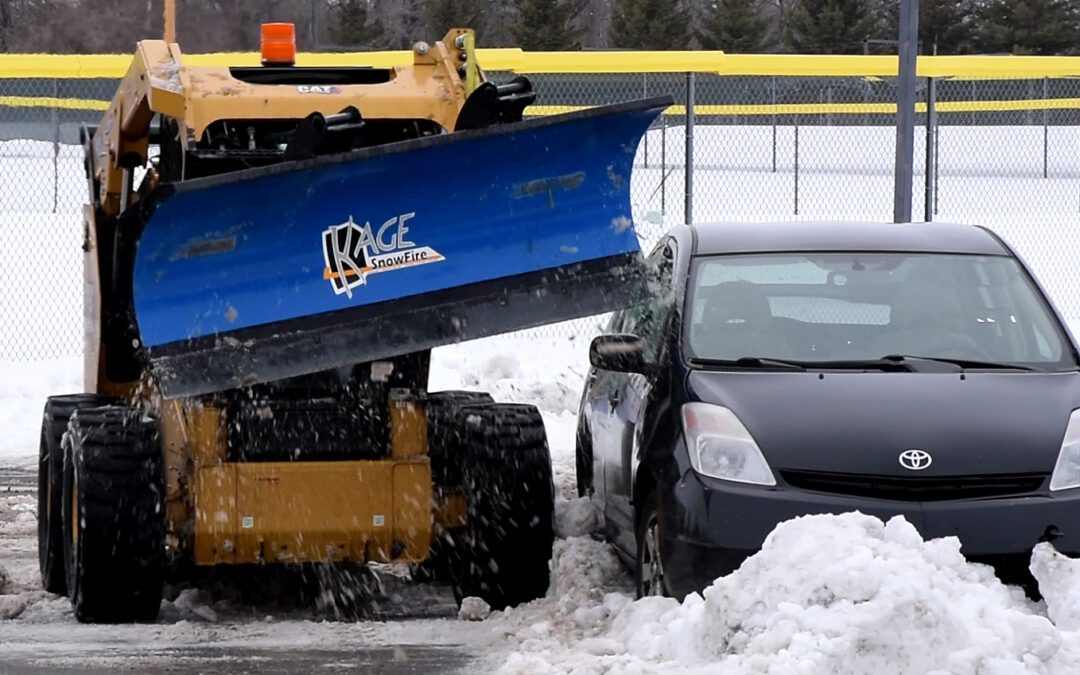

Recent Comments